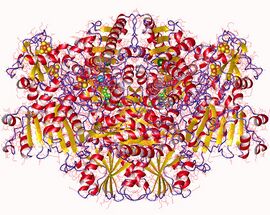Biology:Pyruvate synthase
| pyruvate synthase | |||||||||
|---|---|---|---|---|---|---|---|---|---|
 pyruvate synthase dimer, Desulfovibrio africanus | |||||||||
| Identifiers | |||||||||
| EC number | 1.2.7.1 | ||||||||
| CAS number | 9082-51-3 | ||||||||
| Databases | |||||||||
| IntEnz | IntEnz view | ||||||||
| BRENDA | BRENDA entry | ||||||||
| ExPASy | NiceZyme view | ||||||||
| KEGG | KEGG entry | ||||||||
| MetaCyc | metabolic pathway | ||||||||
| PRIAM | profile | ||||||||
| PDB structures | RCSB PDB PDBe PDBsum | ||||||||
| Gene Ontology | AmiGO / QuickGO | ||||||||
| |||||||||
In enzymology, a pyruvate synthase (EC 1.2.7.1) is an enzyme that catalyzes the interconversion of pyruvate and acetyl-CoA. It is also called pyruvate:ferredoxin oxidoreductase (PFOR).
The relevant equilibrium catalysed by PFOR is:
- pyruvate + CoA + oxidized ferredoxin [math]\displaystyle{ \rightleftharpoons }[/math] acetyl-CoA + CO2 + reduced ferredoxin
The 3 substrates of this enzyme are pyruvate, CoA, and oxidized ferredoxin, whereas its 3 products are acetyl-CoA, CO2, and reduced ferredoxin.
Function
This enzyme participates in 4 metabolic pathways: pyruvate metabolism, propanoate metabolism, butanoate metabolism, and reductive carboxylate cycle (CO
2 fixation).
Its major role is the extraction of reducing equivalents by the decarboxylation. In aerobic organisms, this conversion is catalysed by pyruvate dehydrogenase, also uses thiamine pyrophosphate (TPP) but relies on lipoate as the electron acceptor. Unlike the aerobic enzyme complex PFOR transfers reducing equivalents to flavins or iron-sulflur clusters. This process links glycolysis to the Wood–Ljungdahl pathway.
Nomenclature
This enzyme belongs to the family of oxidoreductases, specifically those acting on the aldehyde or oxo group of donor with an iron-sulfur protein as acceptor.[1] The systematic name of this enzyme class is pyruvate:ferredoxin 2-oxidoreductase (CoA-acetylating). Other names in common use include:
- pyruvate oxidoreductase,
- pyruvate synthetase,
- pyruvate:ferredoxin oxidoreductase,
- pyruvic-ferredoxin oxidoreductase.
Structure
PFOR adopts a dimeric structure, while each monomeric subunit is composed of one or multiple chain(s) of polypeptides.[1] Each monomeric subunit of PFOR consists of six domains binding one TPP molecule and three [4Fe-4S] clusters.[2]
Catalytic Mechanism
An PFOR reaction starts with the nucleophilic attack of C2 of TPP on the 2-oxo carbon of pyruvate, which forms a lactyl-TPP adduct. Next, the lactyl-TPP adduct releases the CO
2 moiety, forming an anionic intermediate, which then transfer an electron to a [4Fe-4S] cluster. These steps lead to a stable radical intermediate that can be observed by electron paramagnetic resonance (EPR) experiments. The radical intermediate reacts with a CoA molecule, transfers another electron from the radical intermediate to a [4Fe-4S] cluster and forms an acetyl-CoA product.[3]
Inhibitors
- Nitazoxanide is a broad-spectrum antiparasitic drug and FDA-approved PFOR inhibitor which is used for the treatment of Giardiasis and Cryptosporidiosis.[4][5]
- Tizoxanide, an active metabolite of nitazoxanide
- Amixicile, a water-soluble derivative of nitazoxanide, is a potent inhibitor of pyruvate:ferredoxin oxidoreductase and is in pre-clinical studies to treat infections of Helicobacter pylori and Clostridium difficile.[6][7]
References
- ↑ 1.0 1.1 "A structural phylogeny for understanding 2-oxoacid oxidoreductase function". Current Opinion in Structural Biology 41: 54–61. 2016. doi:10.1016/j.sbi.2016.05.011. PMID 27315560.
- ↑ "Binding site for coenzyme A revealed in the structure of pyruvate:ferredoxin oxidoreductase from Moorella thermoacetica". Proc Natl Acad Sci U S A 115 (15): 3846–3851. 2018. doi:10.1073/pnas.1722329115. PMID 29581263.
- ↑ "Pyruvate ferredoxin oxidoreductase and its radical intermediate.". Chemical Reviews 103 (6): 2333–2346. 2003. doi:10.1021/cr020423e. PMID 12797832.
- ↑ "Research perspective: potential role of nitazoxanide in ovarian cancer treatment. Old drug, new purpose?". Cancers (Basel) 5 (3): 1163–1176. 2013. doi:10.3390/cancers5031163. PMID 24202339. "Nitazoxanide [NTZ: 2-acetyloxy-N-(5-nitro-2-thiazolyl)benzamide] is a thiazolide antiparasitic agent with excellent activity against a wide variety of protozoa and helminths. ... Nitazoxanide (NTZ) is a main compound of a class of broad-spectrum anti-parasitic compounds named thiazolides. It is composed of a nitrothiazole-ring and a salicylic acid moiety which are linked together by an amide bond ... NTZ is generally well tolerated, and no significant adverse events have been noted in human trials [13]. ... In vitro, NTZ and tizoxanide function against a wide range of organisms, including the protozoal species Blastocystis hominis, C. parvum, Entamoeba histolytica, G. lamblia and Trichomonas vaginalis [13]".
- ↑ "Nitazoxanide Prescribing Information". Romark Pharmaceuticals. 3 March 2004. pp. 1–9. http://www.accessdata.fda.gov/drugsatfda_docs/label/2004/21497,21498s001lbl.pdf.
- ↑ "Amixicile, a novel inhibitor of pyruvate: ferredoxin oxidoreductase, shows efficacy against Clostridium difficile in a mouse infection model". Antimicrob. Agents Chemother. 56 (8): 4103–11. August 2012. doi:10.1128/AAC.00360-12. PMID 22585229.
- ↑ "Preclinical studies of amixicile, a systemic therapeutic developed for treatment of Clostridium difficile infections that also shows efficacy against Helicobacter pylori". Antimicrob. Agents Chemother. 58 (8): 4703–12. 2014. doi:10.1128/AAC.03112-14. PMID 24890599.
Further reading
- "Photoreduction of ferredoxin and its use in carbon dioxide fixation by a subcellular system from a photosynthetic bacterium". Proc. Natl. Acad. Sci. U.S.A. 53 (6): 1420–5. 1965. doi:10.1073/pnas.53.6.1420. PMID 5217644. Bibcode: 1965PNAS...53.1420E.
- "Purification and properties of -ketoglutarate synthase from a photosynthetic bacterium". J. Biol. Chem. 247 (21): 6963–9. 1972. doi:10.1016/S0021-9258(19)44680-2. PMID 4628267.
- "Pyruvate-ferredoxin oxidoreductase. 3. Purification and properties of the enzyme". J. Biol. Chem. 246 (10): 3111–9. 1971. doi:10.1016/S0021-9258(18)62202-1. PMID 5574389.
- "Pyruvate-ferredoxin oxidoreductase. IV. Studies on the reaction mechanism". J. Biol. Chem. 246 (10): 3120–5. 1971. doi:10.1016/S0021-9258(18)62203-3. PMID 4324891.
- "Structure and electron transfer mechanism of pyruvate:ferredoxin oxidoreductase". Curr. Opin. Struct. Biol. 9 (6): 663–9. 1999. doi:10.1016/S0959-440X(99)00027-5. PMID 10607667.
 |

